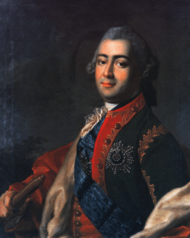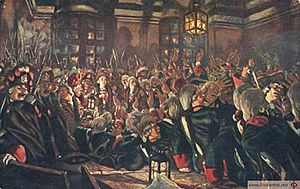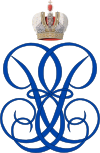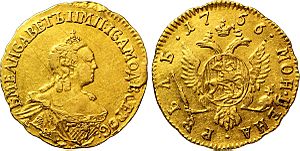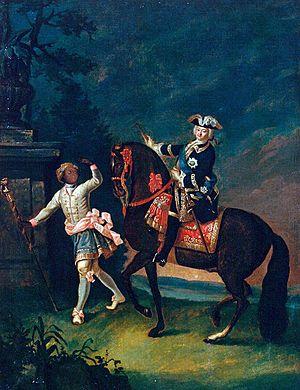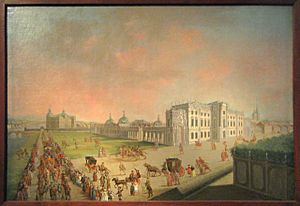Elizabeth of Russia facts for kids
Quick facts for kids Elizabeth |
|||||
|---|---|---|---|---|---|

Portrait by Charles-André van Loo, 1760
|
|||||
| Empress of Russia | |||||
| Reign | 6 December (25 November) 1741 – 5 January (25 December) 1762 | ||||
| Coronation | 6 May (25 April) 1742 | ||||
| Predecessor | Ivan VI | ||||
| Successor | Peter III | ||||
| Born | Elizaveta Petrovna Romanova 29 December 1709 Kolomenskoye, Moscow, Tsardom of Russia |
||||
| Died | 5 January 1762 (aged 52) Winter Palace, Saint Petersburg, Russian Empire |
||||
| Burial | 3 February 1762 (O.S.) Peter and Paul Cathedral |
||||
|
|||||
| House | Romanov | ||||
| Father | Peter I of Russia | ||||
| Mother | Catherine I of Russia | ||||
| Religion | Russian Orthodoxy | ||||
| Signature |  |
||||
Elizabeth Petrovna (born December 29, 1709, died January 5, 1762), also known as Yelisaveta or Elizaveta, was the Empress of Russia from 1741 until her death. She is remembered as one of Russia's most popular rulers. People admired her for not ordering any executions during her reign. She also started many building projects and strongly opposed the policies of Prussia.
Elizabeth was the daughter of Peter the Great, a famous Russian Tsar. After her father's death, Russia faced a time of unclear successions to the throne. Her mother, Catherine I, ruled first. Then came her nephew, Peter II, and later her cousin, Anna. After a short rule by a baby emperor, Ivan VI, Elizabeth took the throne with the army's help. She then named her own nephew, who would become Peter III, as her heir.
During her time as Empress, Elizabeth continued her father's work to modernize Russia. She brought a period of great learning and art, known as the Age of Enlightenment, to Russia. She allowed nobles to have more power in local government. She also supported the creation of the University of Moscow, which is still a top school today. Her royal court was one of the most magnificent in Europe. She improved Russia's roads and supported the Imperial Academy of Arts. She also funded grand building projects by her favorite architect, Bartolomeo Rastrelli. Famous buildings like the Winter Palace and the Smolny Cathedral in Saint Petersburg were built during her reign.
Elizabeth led the Russian Empire through two major European wars: the War of Austrian Succession and the Seven Years' War. Russia formed alliances with Austria and France. Russian troops won several battles against Prussia and even occupied Berlin for a short time. Elizabeth died in January 1762, just when Prussia's king was thinking of giving up. She was the last female ruler from the direct male line of the House of Romanov.
Contents
Early Life and Family
Childhood and Growing Up
Elizabeth was born on December 18, 1709, in Kolomenskoye, near Moscow. Her parents were Peter the Great, the Tsar of Russia, and Catherine I. Her parents had secretly married in 1707, and then officially in 1712. Elizabeth and her older sister, Anna, were officially recognized as princesses. Of Peter and Catherine's twelve children, only Elizabeth and Anna survived to adulthood.
Elizabeth was her father's favorite. She was like him in looks and personality. Even though he loved her, Peter the Great didn't focus much on her education. He didn't expect a daughter to become ruler, as Russia had never had a female empress before. So, her mother, Catherine, who also lacked much education, raised the girls.
Despite this, Elizabeth was a bright girl. She had a French governess who taught her math, art, languages, and sports. She became interested in architecture and learned to speak Italian, German, and French fluently. She was also an excellent dancer and rider. Like her father, she loved being active. She enjoyed horseriding, hunting, sledging, skating, and gardening.
From a young age, Elizabeth was known for her lively personality and beauty. The wife of the British ambassador described her as "fair, with light brown hair, large sprightly blue eyes, fine teeth and a pretty mouth." She was also noted for being "extremely gay" and friendly.
Marriage Plans and Personal Life
Peter the Great wanted his daughters to marry into royal families in Europe. This was part of his plan to modernize Russia. Elizabeth was engaged to Charles Augustus of Holstein-Gottorp in 1724. However, her fiancé died in 1727, just before their wedding. This was a sad time for Elizabeth, as her mother, Empress Catherine I, had also died just two weeks earlier.
By May 1727, 17-year-old Elizabeth had lost her fiancé and both parents. Her half-nephew, Peter II, became the new ruler. Her chances of marriage didn't improve when her cousin, Anna, became Empress in 1730. There was little love between the cousins. No Russian nobleman or foreign prince wanted to marry Elizabeth. She couldn't marry a commoner either, as that would mean losing her royal status and claim to the throne.
Because she couldn't marry, Elizabeth found companionship with Alexei Razumovsky. He was a kind and handsome Ukrainian peasant with a beautiful singing voice. A nobleman brought Razumovsky from his village to sing in a church choir. Elizabeth bought him from the nobleman for her own choir. Razumovsky was a simple man and never showed interest in politics. He remained devoted to Elizabeth throughout her life. Many believe they even married in a secret ceremony. In 1742, he was made a count, and in 1756, Elizabeth made him a prince and a field marshal.
Taking the Throne
During the rule of her cousin, Empress Anna, Elizabeth quietly gained support. As the daughter of Peter the Great, she was popular with the Russian Guards regiments. She often visited these elite soldiers, attending their events and becoming godmother to their children.
After Empress Anna died, her infant great-nephew, Ivan VI, became emperor. His mother, Anna Leopoldovna, ruled as regent. This period was marked by high taxes and economic problems. The French ambassador in Saint Petersburg, the Marquis de La Chétardie, helped plan a coup to remove the regent. He bribed many officers in the Imperial Guard to support Elizabeth.
On the night of November 25, 1741, Elizabeth took power with the help of the Preobrazhensky Life Guards Regiment. She arrived at their headquarters wearing a soldier's metal breastplate over her dress and holding a silver cross. She asked them, "Whom do you want to serve: me, your natural sovereign, or those who have stolen my inheritance?" The soldiers agreed to support her. They marched to the Winter Palace and arrested the young Emperor Ivan, his parents, and their military commander. This daring coup succeeded without bloodshed. Elizabeth had promised that if she became Empress, she would never sign a death sentence, a promise she kept throughout her reign.
However, there was still some harshness in her rule. Although she first thought of letting Ivan and his mother leave Russia, she later imprisoned them in Shlisselburg Fortress. She worried they might cause trouble for her in Europe. To prevent any attempts to free Ivan, Elizabeth ordered that all papers or coins showing him be destroyed. She also ordered that if Ivan tried to escape, he should be killed. This order was later carried out when an attempt was made to free him.
Elizabeth's Reign
Elizabeth crowned herself Empress in the Dormition Cathedral on April 25, 1742. She was 33 years old and had little political experience. She found herself leading a great empire during a very important time. Her proclamation stated that previous rulers had harmed Russia. She promised to free the Russian people from "degrading foreign oppression."
Russia had been heavily influenced by German advisors. Elizabeth exiled the most unpopular ones, including Andrey Osterman. She also passed laws that reversed some of her father's changes to limit the church's power.
Despite some weaknesses, Elizabeth had a natural talent for government, much like her father. Her sharp judgment and diplomatic skills often reminded people of Peter the Great. What sometimes seemed like hesitation was often a wise delay in making decisions during difficult times. From Russia's perspective, her greatness came from her strong understanding of national interests and her determination to protect them.
Education and Culture
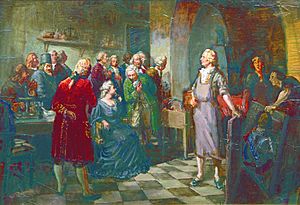
Even though Elizabeth didn't have a strong early education, she understood the importance of learning. She laid the groundwork for future advancements, especially for her successor, Catherine the Great. She made education available to all social classes, except for serfs. She encouraged Mikhail Lomonosov to establish the first university in Russia. She also helped fund the Imperial Academy of Fine Arts.
Internal Peace and Justice
Elizabeth was a skilled diplomat who disliked violence. She worked hard to change Russia's system of punishment, even making capital punishment illegal. Historian Robert Nisbet Bain noted that one of her greatest achievements was stopping the harmful conflicts between rival groups at court. These conflicts had troubled previous reigns and allowed foreign powers to interfere in Russia's affairs.
Building Projects
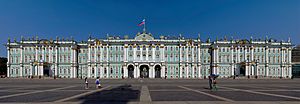
Elizabeth loved architecture and oversaw many building projects during her reign. One of the most famous projects by Italian architect Bartolomeo Rastrelli was the rebuilding of Peterhof Palace. Her most well-known creations were the Winter Palace, which she didn't live to see finished, and the Smolny Convent. The Winter Palace is said to have 1,500 rooms, 1,786 doors, and 1,945 windows.
Building projects were very important to the Empress. Work continued all year, even in the harsh winter months. Huge sums of money were spent, raised by taxes on state-owned taverns. When more money was needed, taxes on salt and alcohol were increased. Elizabeth's grand spending greatly improved the country's infrastructure. To get goods from all over the world, many roads across Russia were modernized under her orders.
Choosing an Heir
Since Elizabeth was unmarried and had no children, she needed to choose an heir to continue the Romanov dynasty. She chose her nephew, Peter of Holstein-Gottorp. Young Peter had lost his mother shortly after birth and his father at age eleven. Elizabeth invited him to Saint Petersburg, where he joined the Russian Orthodox Church and was named heir to the throne on November 7, 1742.
To secure the dynasty, Elizabeth gave Peter the best Russian tutors. She also chose Sophie of Anhalt-Zerbst to be his bride. Sophie's mother was the sister of Elizabeth's own fiancé, who had died before their wedding. When Sophie converted to the Russian Orthodox Church, she was given the name Catherine, in honor of Elizabeth's mother. The marriage took place on August 21, 1745. Nine years later, their son, Paul I, was born on September 20, 1754.
Elizabeth took a very active interest in Paul's upbringing, acting almost like his mother. Shortly after his birth, she ordered the midwife to take the baby. Catherine, Paul's mother, did not see her child again for a month. The child effectively became a ward of the state.
Foreign Policy and Wars
Elizabeth ended the cabinet council system used by Empress Anna. She brought back the Governing Senate as it had been under Peter the Great. Her first major task was to deal with the war against Sweden. Peace talks began in 1743. In the Treaty of Åbo, signed on August 7, 1743, Sweden gave Russia all of southern Finland east of the Kymmene River. This river then became the new border between the two countries. Russia also gained the fortresses of Villmanstrand and Fredrikshamn.
Bestuzhev's Influence
The success in gaining land from Sweden was largely due to the diplomatic skills of the new vice chancellor, Aleksey Bestuzhev-Ryumin. Elizabeth fully supported him. She put Bestuzhev in charge of foreign affairs right after she became Empress. He wanted Russia to ally with England and Austria, which was good for Russia at the time. Despite attempts by Frederick the Great and Louis XV to remove Bestuzhev, he kept Elizabeth's strong support.
Bestuzhev achieved many things. His diplomacy and sending 30,000 troops to the Rhine helped speed up peace talks, leading to the Treaty of Aix-la-Chapelle in 1748. He helped Russia out of its conflict with Sweden and improved relations with Austria and England. He also helped Russia become more powerful in Poland and the Ottoman Empire. He isolated the King of Prussia by forcing him into alliances against Russia. All of this was possible because Elizabeth trusted him completely, even though he had many enemies.
However, on February 14, 1758, Bestuzhev was removed from his position. He lost all his honors and rank. No one knew exactly why, but it was thought he tried to cause problems between the Empress and her heir. Bestuzhev's rivals, including the Shuvalov family and Vice-Chancellor Mikhail Illarionovich Vorontsov, were against his pro-Austrian policies.
The Seven Years' War
A major event in Elizabeth's later years was the Seven Years' War. Elizabeth saw the Convention of Westminster (1756), where Great Britain and Prussia agreed to work together, as a threat to Russia's agreements with Great Britain. Elizabeth disliked Frederick the Great personally. She wanted to limit his power so he would no longer be a danger to the Russian Empire. Elizabeth joined the Second Treaty of Versailles, forming an alliance with France and Austria against Prussia. On May 17, 1757, the Imperial Russian Army, with 85,000 soldiers, marched towards Königsberg.
Even with Elizabeth's serious illness, Bestuzhev's removal, and many plots by foreign powers, the war continued. The crushing defeat of Prussia at the Battle of Kunersdorf (August 12, 1759) brought Frederick close to ruin. He almost gave up, but was saved by disagreements between the Russian and Austrian commanders.
From late 1759 to late 1761, Elizabeth's strong desire to win was the main force holding together the allies against Prussia. She insisted that the King of Prussia must be reduced to the rank of a Prince-Elector. Frederick himself knew how much danger he was in. He wrote in early 1760 that the war meant "utter ruin" for him.
In 1760, a Russian army briefly occupied Berlin. Russian victories put Prussia in serious danger. The campaign of 1761 was not very successful, but the capture of the Prussian fortress of Kolberg on Christmas Day 1761 was Russia's only major success. Frederick was at his breaking point. On January 6, 1762, he wrote that they should try to save "whatever fragments of my territory we can." A few weeks later, he wrote, "The sky begins to clear. Courage, my dear fellow. I have received the news of a great event." This "miracle" that saved him was the death of Empress Elizabeth on January 5, 1762.
Siberia
In 1742, the Russian government ordered a military expedition to conquer the Chukchi and Koryaks in Siberia. This expedition failed, and its commander was killed in 1747. By 1750, it was clear that the Chukchi would be hard to conquer. Elizabeth then changed her approach and made a formal peace agreement with them.
Elizabeth's Royal Court
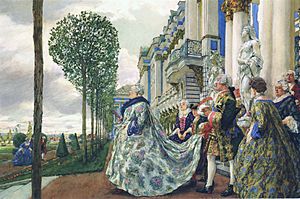
Elizabeth's court was one of the most magnificent in all of Europe. Historian Mikhail Shcherbatov said that the court was "arrayed in cloth of gold." Nobles wore the most luxurious clothes, ate the most expensive foods, and drank rare drinks. They had many servants and applied this lavish standard to everything. A huge amount of silver and gold items were made, more than ever before in Russia's history. It was common to order over a thousand bottles of French champagne and wines for one event. Pineapples were served at all receptions, even though they were hard to get in such large amounts.
French plays quickly became very popular and were often performed twice a week. Music also became very important. Many believed its popularity was due to Elizabeth's supposed husband, Alexei Razumovsky, who loved music. Elizabeth spent a lot of money to bring top musicians from Germany, France, and Italy. She reportedly owned 15,000 dresses, thousands of pairs of shoes, and countless stockings.
Elizabeth was attractive when she was young and vain as an adult. She issued rules to make herself stand out. For example, she forbade anyone from wearing the same hairstyle, dress, or accessory as the Empress. One woman accidentally wore the same item as the Empress and was punished. Another rule required French fabric sellers to sell to the Empress first.
One famous story shows her vanity: once, Elizabeth got some powder in her hair and had to cut a patch of it out to remove it. She then made all the court ladies cut patches out of their own hair, which they did "with tears in their eyes." This strong focus on appearance continued throughout her reign, especially as she got older.
Despite her sometimes harsh reactions about her appearance, Elizabeth was cheerful in most other matters, especially when it came to court entertainment. She reportedly held two balls a week. One was a large event with about 800 guests, including merchants, lower nobility, and guards. The other was a smaller gathering for her closest friends and the highest-ranking nobles. These smaller events started as masked balls but became famous "metamorphoses balls" by 1744. At these balls, guests were expected to dress as the opposite sex. Elizabeth often dressed as a Cossack or a carpenter, honoring her father. Most courtiers disliked these balls because many guests looked silly by decree. But Elizabeth loved them. She was described as "the only woman who looked truly fine and completely a man" in male attire. Elizabeth also often hosted children's birthday parties and wedding receptions for those connected to her court. She even provided dowries for each of her ladies-in-waiting.
Death
In the late 1750s, Elizabeth's health began to worsen. She had many dizzy spells and refused to take her prescribed medicine. The Empress forbade the word "death" in her presence. However, she suffered a stroke on December 24, 1761. Knowing she was dying, Elizabeth used her last strength to make her confession and say goodbye to those who wished to be with her, including Peter and Catherine.
The Empress died the next day, on Orthodox Christmas, 1761. For her lying in state, she was dressed in a shimmering silver dress. People said she was as beautiful in death as she had been in life. She was buried in the Peter and Paul Cathedral in Saint Petersburg on February 3, 1762, six weeks after her lying in state.
Images for kids
See also
 In Spanish: Isabel I de Rusia para niños
In Spanish: Isabel I de Rusia para niños




